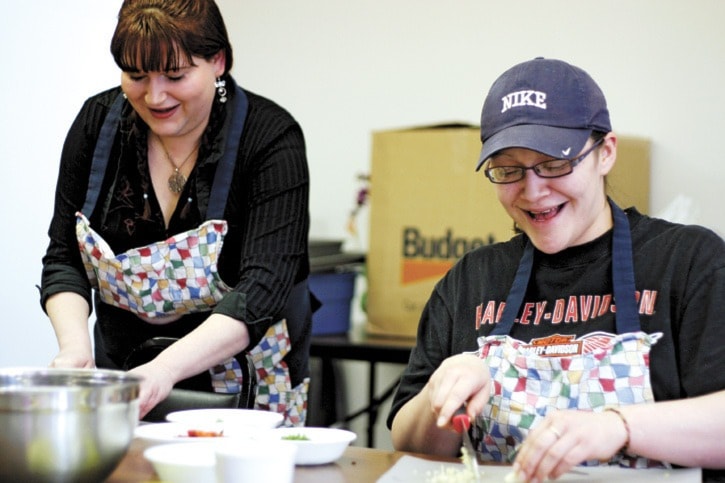Take 13 people excited to cook from scratch, chop them into groups and pair each with a healthy new dish.
Then blend in some nutrition tips, add a dash of budgeting advice and voilà, you have a recipe for the tastiest class in Houston.
Speaking as she diced a fresh green jalapeño pepper, Maria Trottier said she joined Houston Link to Learning's family food skills class because she knows how to cook, but she wants to know how to cook healthy.
"Last week was awesome," Trottier said on week three of the six-week course. "Everyone was energized, and I went home and decided to totally change our eating habits."
The aprons come out Thursday mornings, after Trottier and a dozen others meet up in the kitchen of St. Clement Anglican Church.
Young children are looked after in a room just down the hall. That's a big draw for Trottier, who has a one-year-old daughter and a four-year-old son.
Trottier also said that as a diabetic, she is especially glad for the nutrition lessons in the class, which is put together by the BC Diabetes Association.
"I can do way more in a day when I eat heathy," she said.
Sandwiched between a chopping block full of onions and a pot of salmon chowder simmering on the stove, Lana Wright says she likes to cook with fresh ingredients.
"There's a lot of chopping," she said with a laugh. "But it's worth it in the taste and the nutrition for sure."
Organizer Belinda Lacombe said Thursday's class started with three M's—meat, milk, and meat alternatives.
Meat-eaters, for instance, were told to shop for round, loin and sirloin cuts, all of which have less fatty marbling than ribs or rib-eye and t-bone steaks.
And as for milk, the class learned to favour lower fat cheeses—those with 20 per cent or less milk fat. Stronger cheeses tend to have lower milk fat than mild ones, said Lacombe.
"You get the flavour, but not the fat."
Along with healthy eating tips, Lacombe said a key part of the class is smart food shopping.
In a few weeks they will tour Houston's Super Valu with nutritionist Wendy Orienti, who will hep them map the five healthy food groups onto a grocery store floor plan.
Basically, Lacombe said she teaches that it's best to "shop the sides."
Most grocery stores pack their meat, bread, dairy and produce along the walls inside the store, she explained, leaving fattier, high-carb foods for customers to walk past in the aisles in-between.
Lacombe said she is learning things herself, even after teaching several kitchen classes in Houston.
For one thing, Lacombe said she no longer believes it's more expensive to cook things from scratch.
"There is a higher cost upfront," she explained, as people buy things such as olive oil for cooking instead of butter. But in the end, she said, it's cheaper to eat healthy.
"As your body changes, you need to eat less, but you feel just as full."
Lacombe is one of 143 people teaching the food skills course across B.C. Started in Sept. 2008, the class has been delivered to over 2500 people who are often the primary cooks in their families.
A 2011 report by the BC Diabetes Association said the biggest change they see in people who take the class is that they eat more fresh fruits and vegetables—up to or above the recommended five to seven helpings a day.
They also use less fat, sugar and salt in their cooking, the report said, and they make more food using fresh ingredients.
